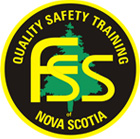Logging Truck & Half-Ton Truck Collide Head-On
Hazard Alert
Drive Appropriately for Conditions
The contractor was driving his half-ton truck inbound on a Company road enroute to his machine. He collided with a loaded log truck that was outbound, heading toward Highway 8. Both drivers were calling out their positions on the CB radio system. The half-ton driver could not hear the log truck driver. The log truck driver heard the half-ton driver and reduced his speed for the on-coming vehicle. The collision occurred on a blind corner at the bottom of a hill. The driver of the log truck veered to the right and came to a stop in the snow bank on the shoulder of the road. The half-ton driver had already started down the hill when he saw the on-coming headlights. He applied the brakes upon seeing the log truck. Once the half-ton truck lost traction and began to slide, the operator shifted into reverse in an attempt to stop. This may have contributed to the loss of vehicle control. The half-ton hit the log truck head-on. Contact was made on the front left corner of each vehicle. Airbags were not deployed in either vehicle. Road conditions were slippery. There were no injuries as a result of the accident.
Recommendations to Prevent a Recurrence
Drive appropriately for road conditions and watch for on-coming traffic. Do not rely solely on the use of CB radios to confirm on-coming traffic
